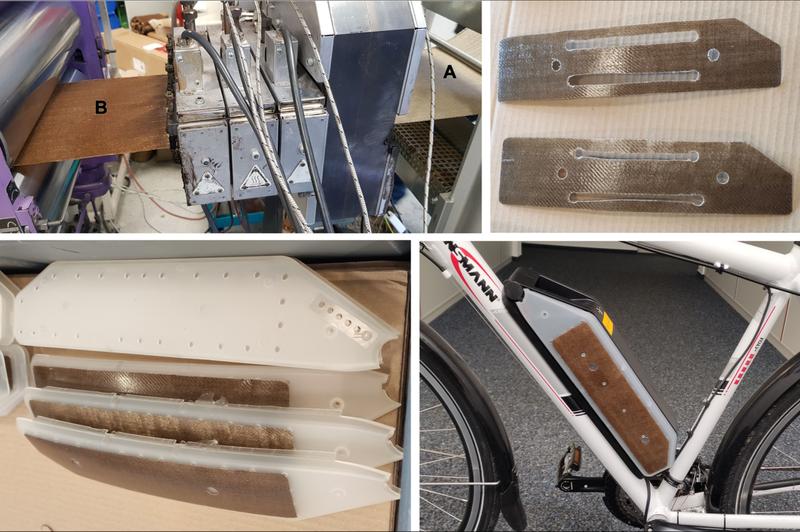
Natural Fiber Reinforced Plastics for Li-Ion Battery Housings

Thin organic sheets (B) are made from flax fabrics (A) and polypropylene to reinforce the housing panels of an e-bike battery.
© Ansmann AG & Fraunhofer LBF
To respond individual customer requirements and to meet social and political responsibility, a research project was carried out in cooperation between Ansmann AG and Fraunhofer Institute für Structural Durability and System Reliability LBF. Aim was the development of natural fibre-reinforced plastics for usage in Li-ion battery housings.
Fraunhofer Researchers will present more details at the Fraunhofer booth, Hall 7, SC01, at the “K-Messe” in Düsseldorf from October 19 to 26.
Current trends demonstrate the growing importance of sustainable products and production processes. Drivers here are not only emission regulations, but also the growing awareness of the environment and sustainability in society.
Therefore, more sustainable solutions are needed to transform the product as well as the value chain and product development.
Sustainable lightweight construction means innovative future technology. Researchers at the Fraunhofer LBF are deliberately pushing the limits of what is feasible. This results in property-optimized, lightweight structural solutions – always considering the reliability, sustainability, and affordability of the technical product solution.
Lightweight construction with natural fibre-reinforced plastics used for Li-ion battery housings
To respond individual customer requirements and to meet social and political responsibility, a research project was carried out in cooperation between Ansmann AG and the Fraunhofer LBF. Aim was the development of natural fibre-reinforced plastics for usage in Li-ion battery housings.
Due to their low density, good mechanical properties, low tendency to splinter and the comparatively low costs, while at the same time increasing sustainability, such natural fibre reinforced plastics were convincing as an alternative to glass or carbon fibre reinforcement.
Process to produce NFRP organic sheets with reduced thermal stress on the natural fibers
At the Fraunhofer LBF, a new process was developed to impregnate different natural fibre fabrics with plastic melt at reduced contact times and modify them according to requirements. Based on an adapted component design of the battery housing, to meet the numerous standards, local natural fibre reinforcements were integrated into the housing using an innovative injection moulding process.
Compared to the standard housing, the NFRP-Housing impresses with a weight reduction of 30 percent and a simultaneous increase in rigidity of 15 percent, while at the same time addressing the principle of efficient and environmentally friendly use of resources
Wissenschaftliche Ansprechpartner:
Shilpa Khare, shilpa.khare@lbf.fraunhofer.de
Dr. Christian Beinert, christian.beinert@lbf.fraunhofer.de
Weitere Informationen:
http://www.lbf.fraunhofer.de/en/projects/lightweight-biobased-plastics.html More information to the project












